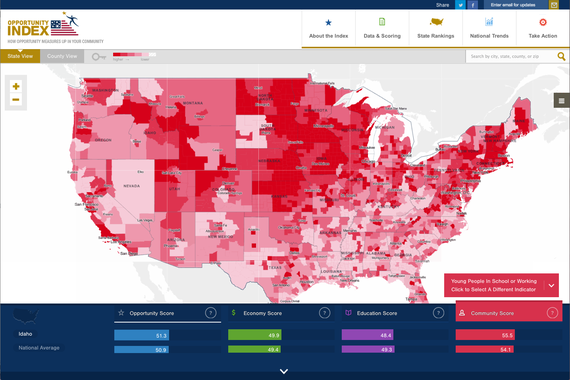There are one in seven young people ages 16-24 who are not in school nor working. The country is beginning to talk about these 5.8 million young people -- the so-called "disconnected youth"-- thanks to new data from the the 2013 Opportunity Index and Measure of America's report Halve the Gap: Youth Disconnection in America's Cities.

A view of youth disconnection in the United States today from the interactive Opportunity Index website. Lighter color shade equals higher youth disconnection rates.
Who are these young people, and how did they end up so off-course?
There is no one single answer.
They are white and black, Hispanic and Asian. They are middle-class and poor, native born and immigrants. They live in rural, suburban and urban areas.
Some struggled in school and lacked adequate supports to make it to graduation day. They include in their number the estimated 1 million students who drop out of high school each year, and fall through the cracks. Others are teen parents or foster care children who "aged out" of the system without a clear plan for adulthood.
Many are looking for work that they can't find, often because they lack the technical, communication and problem-solving skills required by today's job market. And too many young people can't come up with the money to pay for increasingly expensive post-secondary job training or college they need to get ahead. In fact, some of them enrolled in college, only to drop out because of financial constraints.
Yet we know that young people are key to vibrant neighborhoods, communities and economies. The two factors that correlate most with a region's Opportunity Score are the number of people living below the federal poverty line and the percentage of young people ages 16-24 who are not in school or not working. If we can reconnect more youth to meaningful educational and career pathways, we will all benefit.
The personal and collective costs of youth disconnection are steep. Young adults who are not in school or working cost taxpayers $93 billion annually and $1.6 trillion over their lifetimes in lost revenues and increased social services.
There are plenty of reasons for youth disconnection -- societal, familial, financial, educational, personal. But other countries have figured out ways to support families, children and students that produce more equitable societies, adaptable economies and richer environments for opportunity. We can, too.
The fact is, the U.S. must do more to retool our educational supports, economic systems and federal policies so that our young people can meet the challenges of the 21st century global economy.
Whether liberal or conservative; working in government, business or the nonprofit sector; leaders or everyday Americans, we all have a role to play. Fortunately, there are success stories all around the country we can learn from and emulate.
Hundreds of organizations and leaders, including members of Opportunity Nation's diverse coalition, are succeeding in helping young people stay in school, get valuable job experience and skills and earn some form of post-secondary degree or credential.
Year Up, a one-year intensive program that provides low-income young adults ages 18-24 with a combination of hands-on skill development, college credits and corporate internships has helped 6,000 young people reach their potential.
Tiana Robinson struggled with low-self confidence and was getting turned down for jobs because she lacked experience. After friends encouraged her to apply to Year Up, the organization helped her to secure an internship at Sutter Health Information Services in San Francisco, where she flourished.
She says:
If I hadn't found Year Up I would probably be working three jobs just to survive and wouldn't have time for school. I plan to continue with my education so that I will have options... Everyone has a dream; some struggle more to make their dreams happen. I know because I am living proof of what 'bridging the gap' looks like. My dreams have become my reality.
So, who are disconnected youth? They are our future and deserve our urgent attention and investment. We all have a stake in helping the next generation meaningfully connect to education, the economy and civic life and restoring our promise as a land of opportunity.
Mark Edwards is the Executive Director of Opportunity Nation, a national, bipartisan campaign working to expand economic mobility and close the opportunity gap across America. Mr. Edwards also serves on the board of Horizons for Homeless Children, an experience that led him to build a national effort to increase economic opportunity for Americans. Opportunity Nation focuses on increasing awareness around opportunity-related issues, encouraging collaboration among public and private sectors, and advocating bipartisan federal policy changes targeted to improve the quality of life for Americans.